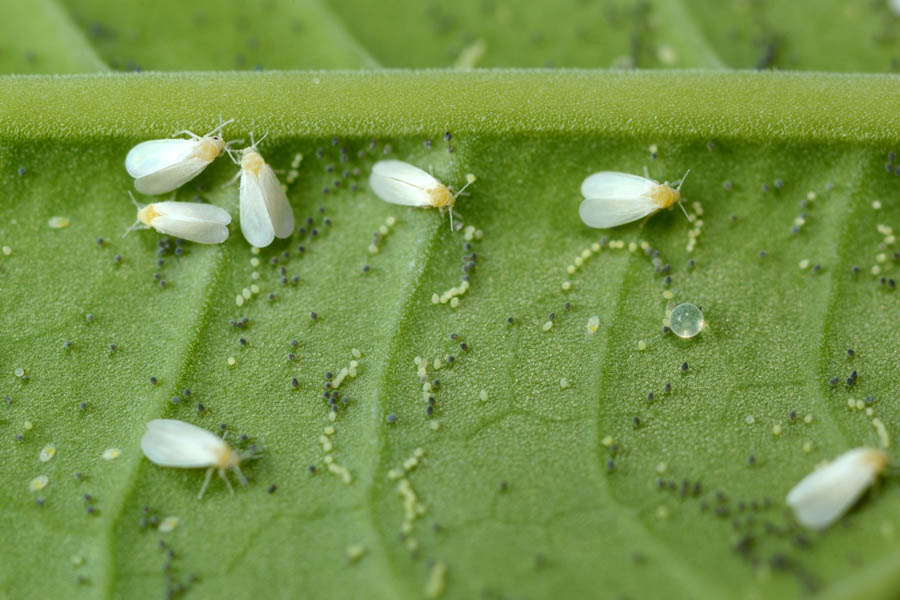Whiteflies in the California Home Garden, Part 2 of 3: Prevention and Monitoring

The photo above shows whitefly adults, eggs, and a few oval nymphs at left. The sphere at middle right is a droplet of liquid, either water or fluid from the plant.
GardenZeus earns commissions on sales made through links in this article. There is no additional cost to you.
This is the second in a series of three articles discussing whiteflies in the California home garden.
Most common pest whitefly species have a broad host range, meaning that they can feed on and infest many different kinds of plants. The combined host range for the most-common species includes many garden vegetables, especially solanums (tomatoes, potatoes, eggplants, and peppers); cucurbits such as cucumbers and melons; other vegetables; berries including strawberries and blackberries; fruit trees, especially citrus, avocado, and pomegranate; and many ornamental woody plants and trees. They also infest various weed species and wild plants.
It’s important to monitor vegetable gardens, citrus trees, and other susceptible plants and trees, particularly from June or July through October or November, with yellow sticky traps, homemade sticky traps, or with visual examination at least twice per week. Whitefly infestations are often easy to control when caught early, and can be almost impossible to manage or eliminate once severe.
Whiteflies have many insect predators. The best defense is a thriving, healthy garden or landscape with habitat that supports their natural enemies, including ladybugs, lacewings, parasitic wasps, and minute pirate bugs. Pesticides often do more harm than good, leading to repeat cycles of infestation, as they kill natural enemies, which recover more slowly than whiteflies.
Reflective mulches may discourage infestations in new plantings or on small plants, but become ineffective for trees and larger plants, and may harm plants with too much reflected heat or sunlight. Whiteflies may be introduced to a garden or landscape when bringing in new plants; be sure to check all purchased and introduced plants for pests and diseases.
How do you know if your plants have whiteflies? Check the undersides of leaves. Yellowing, curling, and drooping leaves or necrotic/brown leaf areas may signal infestation.Yellow sticky traps provide the most-accurate monitoring. Sooty mold, a black mold that grows on the honeydew excreted by whiteflies and other sucking insects, may appear on plant parts or surfaces below infested leaves. When you find sooty mold, check the undersides of leaves above.
For a fast and easy whitefly test, gently shake the plant or a few branches. This will disturb adults into flight, and can often give a rough indication of severity of infestation. Flying adults confirm whitefly presence, but absence of flying adults does not rule it out. Examine the undersides of leaves, with hand lens if needed, to look for nymphs, and for some species, check for the more-obvious white filaments or beards produced by nymphs that may be mistaken for fungus. As infestations progress, adult and nymph populations become obvious on leaf undersides.
GardenZeus has customized gardening information for your area. To get started, enter your zip code here.
Other articles of interest:
Whiteflies in the California Home Garden, Part 1 of 3: Introduction
Whiteflies in the California Home Garden, Part 3 of 3: Treatment and Control

